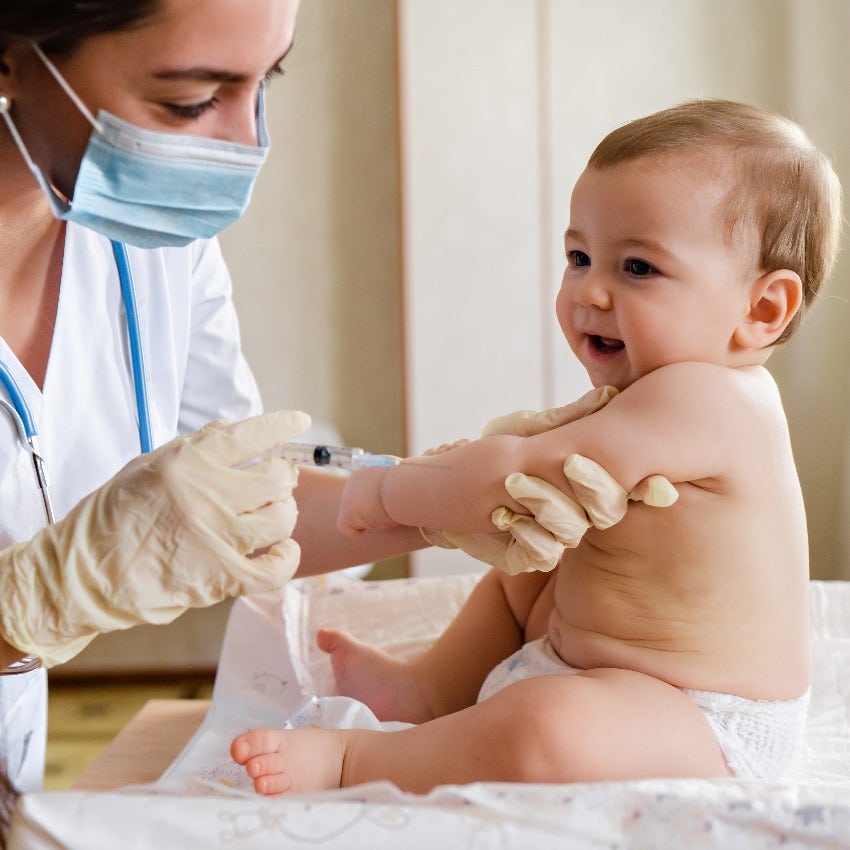The Mom Fail That Made Me A Better Doctor
My empathy for parents increased ten-fold when I became one.
 Courtesy of Author
Courtesy of Author I did four years of emergency medicine residency and several years as a full-time attending physician in a busy suburban emergency department, yet one pesky little parenting problem stopped me in my tracks. When my toddler son became sick with a high fever, I could not get him to take medicine. I learned a valuable lesson that they do not teach in med school or residency.
My son, Ben, had a high fever and was very clingy. I made the appointment and brought Ben to see his pediatrician, who examined him thoroughly. The doctor did something he did not often do: He drew blood to check a white blood cell count. An elevated white blood cell count can indicate body stress, a response to infection, and a significant illness that needs to be addressed.
I order complete blood counts on my own emergency department patients every day and quite frequently, for ill children. My son’s white blood cell count (WBC) on that day was highly elevated at 35,000. A normal white blood cell count in a child of this age would be in the range of 4,800 to 10,800 cells/mm3.
I tried so hard to be a “good” patient. A quote from my book, Changing How We Think about Difficult Patients, Chapter 2: What Makes a “Good” Patient:
“Most healthcare workers would describe their ideal patients as independent, hardworking, and self-sufficient individuals who are logical and rational in their thinking. These individuals want to be helped, and they respond maturely to their doctors and care providers. They follow advice without overreacting or becoming overly emotional. Good patients recognize that the clinician has imparted wise advice based on training and experience.”
The apprenticeship we go through during internship and residency teaches us a lot about infections, injuries, and patient interactions. What teaches us even more, are the experiences we go through in our own lives. Most young medical students do not have much experience with illness and injury. Most medical students and residents are not parents, yet.
When I hurt my back picking up a stack of old-fashioned X-rays (folks, this was something we had before digital images), I learned a lot about how to treat a lumbar sprain and strain. It was not until I placed myself flat on my back, at bedrest, that I started to get better. After that experience, I had no problem selling my patients on the most effective treatment for a lumbar strain and sprain. I believed so fiercely that my medical advice would work because it worked so well for me.
It is not that one must have experienced a certain illness to advise her patients. I've never experienced an asthma attack, but I can imagine how uncomfortable it must be to feel like you cannot breathe and are exhaling through a narrow straw. I do not have those body parts, but I can conjure up the extreme discomfort of epididymitis and orchitis (inflammation of the scrotum and testicles.)
My perspective changed when I became a mother.
I previously thought I had empathy for the mothers and fathers who brought their crying, inconsolable children into the emergency department at 3:00 in the morning. I saw that panicked look the parents had on their faces as their seizing child lay on the gurney in the emergency department. The nurses and I would look at those parents with the calm and confidence of people who saw this very same thing two or three times a week. We knew what to do.
But oh, when that crying comes from your own child. When nothing you try seems to relieve their colicky discomfort, I felt a mother’s pain. My premature twins woke up every three hours for feeding. The feeding, burping, and changing of each one took about 45 minutes!
All the times my daughter wailed, I worried, she would wake up her twin brother who slept in a crib in the same room. I fretted about that for two years and it never happened. How much angst and time did I waste worrying about that?
Then came the time to start feeding the twins solid foods. Whenever any food with texture or solid matter touched the back of Ben’s throat, he brought it back up, all the contents of his stomach. For a year longer than usual, we had to stick to soft or pureed foods.
I had written hundreds, perhaps over a thousand prescriptions by that time, for young parents to give the common antibiotics, pain relievers, or other medications to their infant children. My nurses dutifully instructed the parents on how to give weight-appropriate doses of acetaminophen or ibuprofen to the little darlings.
 Alena Ozerova / Shutterstock
Alena Ozerova / Shutterstock
I never gave too much thought about how the parents would get the kids to take the medicines.
Fortunately, Ben was a healthy child who mostly stayed at home with his twin sister and his parents or our nanny. But then I started taking him to childcare at the gym or to play dates with the other kids in the neighborhood. He started getting viruses and, inevitably, some cases of inner ear infections that would require medication.
When Ben got a fever, I thought I had the solution all figured out. Acetaminophen (trade name: Tylenol) comes in rectal suppositories with various potencies that can be dosed according to the child’s weight. Suppositories are super-easy to insert in young children and most of us are in that vicinity when we change their diapers.
You just place a little lubricant (like petroleum jelly) over the entry to the rectum and place the suppository on the tip of your pinky finger. You can use a glove. Just fold the legs up and place that little bullet-shaped suppository inside the child’s rectum. If you do not get it in, the child can push it out. Just an inch or so in the child has gotten his fever or pain medicine.
I would eventually advise all the emergency department parents to keep some acetaminophen suppositories in the fridge for when their children would need the fever or pain control but were either vomiting or would not willingly take medications. For about 12 years, if you checked the door of my suburban Alexandria fridge, tucked in the back behind four types of mustard, six different salad dressings, and a half-filled jar of capers, you would find a box of acetaminophen suppositories.
If I were seeing my same sick child (Ben) as a physician in the emergency department, I would have initiated a full septic workup. Sepsis is an infection of the bloodstream resulting in a drop in blood pressure and an increase in heart rate and fever. My actions as an ER doc would have included drawing blood cultures, giving an intravenous bolus of saline to rehydrate him, and administering an intravenous dose of antibiotics.
His office-based pediatrician simply handed me a prescription for oral amoxicillin.
I did my level best to be a “good” patient and to follow the doctor’s orders. I felt like the karma of the world was giving me a tremendous jab in the eye. The doctor (me) could not give her son his medicine. I tried to give it, but once the medicine hit his soft palate, the back of his throat, up came the contents of his stomach. Not a little spit-up — everything.
I have a great deal of respect for my son’s pediatrician, who helped us through several challenges. I went home, filled that prescription, and tried as best as I could, to give that child a dose of that antibiotic. It wasn't happening.
I could not get medication into my child.
My doctor’s brain swirled with visions of bacteremia and sepsis. (Those are fancy terms for bacterial infection in the bloodstream and overwhelming infection.)
With my back-door access, I brought him to my emergency department and had one of my colleagues take a quick look. My friend Jane, the RN, took Ben and gave him the appropriate dose of the antibiotic ceftriaxone in an intramuscular injection (a shot), that would appropriately treat him.
 Tatevik Bagdasaryan
Tatevik Bagdasaryan
It would also take care of my guilt and worry. I never even told the pediatrician. Ben got better and that’s mostly what I remember from this story. There are many lessons to be learned.
Why have I told this story? Because I never considered during all my years of training as to how the parents of my pediatric patients would give their kids medicine. This is another thing I took for granted about “good’ patients: They took their medicines as prescribed and they gave their children the medications that I prescribed for them.
And yet, I could not give my own son the medication that he was prescribed.
I've talked to doctors and nurses about their tendency to judge patients and patient’s family members quite harshly. Most young professionals have not had the time to become parents themselves. How can we expect them to truly understand a parent’s point of view?
They probably think, like I did: you just give the baby the medicine. But in real life, it is not so easy. Life teaches us a few lessons along the way. After learning how hard it is to give kids medicine, I now always ask if the parents know how to give the medicine and try to choose medications with the least number of doses per day.
If the medication is difficult to give, or too expensive to obtain, the parents won't do it. And the right medication won't work if parents cannot give it or if the child vomits it all up. This is just one of the lessons that I learned when I became a mother that made me a better doctor.
Joan Naidorf DO is an emergency physician, author, and speaker based in Alexandria, VA. She also reads and reviews books, travels, plays tennis, and serves Dolly the miniature poodle. Her book Changing How We Think about Difficult Patients: A Guide for Physicians and Healthcare Professionals was published in 2022.

